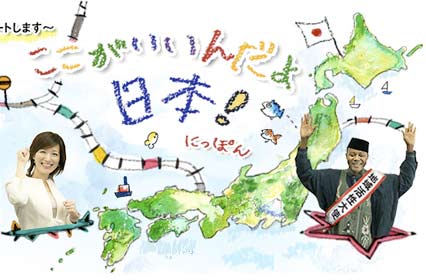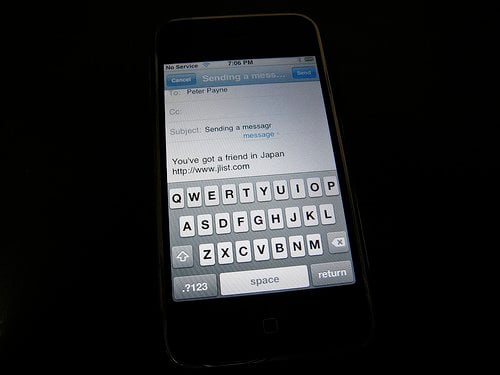I watch more than a little late-night Japanese TV, and I enjoy its light- hearted goofiness. The other night I caught a show featuring Zomahoun, an African from the Republic of Benin who was one of the foreigners to become TV personalities here through a show broadcast a few years ago in which Japanese-bilingual gaijin from various countries would debate issues related to life in Japan on TV. He was being officially initiated into the comedy talent agency run by director Takeshi Kitano, a ceremony which involved the poor man having to put a chameleon in his pants. (This is funny, trust me.) During the show, there was a little window showing a panel of “hosts” who watched the VTR (er, the video feed) along with us, the audience, and the screen would occasionally cut back to these people to get their reaction to what was currently happening. This is a common model for television in Japan — essentially allowing you, the viewer, to experience something as part of a group alongside TV personalities, to cry with them after watching a moving clip, to laugh as Takeshi hits someone over the head with his little squeaking hammer, and so on. I’m sure the “togetherness” viewers feel from watching along with hosts adds something important (or at least makes people watching TV late at night feel less lonely).

Kokusai kekkon, or international marriage, is more popular than ever, as both Japanese men and women become open to the idea of marrying someone from another country. Currently, around 10% of marriages in Japanese cities are international, amazing considering the fact that the gaijin population of Japan is only around 1.5%. While most of the statistics come from Japanese men marrying women from places like China or South Korea, there are plenty of Japanese women marrying foreigners from the West, too. Japanese females often have a rose-colored view of what it must be like to be married to an American, and my wife’s friends often speak enviously of her. “I’ll bet your husband does the dishes every night,” they’ll say (in reality, my wife won’t let me in the kitchen, since I mess up her organization). I’m also assumed to hold doors and chairs, cook an occasional romantic meal, and say “I love you” as I head out the door to work every morning (Japanese husbands are famous for never showing affection). Children produced by such a marriage must surely be “kawaii,” just like having your own living Licca-chan doll (Licca is a popular fashion doll who is half-Japanese, half-French). While I do my best, my wife would be the first to admit that I’m just a regular guy who just happens to be good at noticing things that a normal Japanese husband would miss, like, “if sashimi (刺身) is written with characters that mean ‘stabbing meat’ then why am I not allowed to stab it with my chopsticks?” We get along not because of what country we’re each from, but because of our shared experiences — we both know how hard it is to learn each other’s language, we both grew up watching Mobile Suit Gundam and Fist of the North Star (although in my case, it was my “second childhood” as a Japanese learner, but you know what I mean).
One good thing about learning Japanese: as a bonus, you pick up a little Chinese as well. Since the Japanese writing system is based on kanji, I can figure out the meaning of about 20% of Chinese if I try to read it, which is about the amount of French I get to understand for “free,” courtesy of Norman the Conqueror. I’ve got a copy of the original Star Wars trilogy on DVD from China, and it’s fun to puzzle out what’s being said through the subtitles. One big difference is that Chinese lacks a way to express foreign words (katakana), hence words like “Death Star” or “the Force” get translated into kanji, resulting in “star of mortality” (死亡的星) or “the spiritual power” (精力). Just as eau d’toilette doesn’t mean what English speakers think it means the first time we see it, there’s some shifting of meanings of kanji words from Chinese to Japanese. The character for “festival” (matsuri、祭) is used for funerals in China, making for some real confusion. In Japanese, the characters hand + paper (手紙) represent a letter you’d write to someone, but the same characters mean “toilet paper” in Chinese. J-List’s “Emergency Exit” T-shirt (非常口) has been a popular seller over the years, but these same characters translate as “abnormal mouth” in the language of the Middle Kingdom.
Speaking of kanji, in addition to tasty snacks, plush toys, PC dating-sim games and our patented “wacky things from Japan,” we sell a lot of study related items. Today we’re posting the top-of-the-line electronic dictionary from Casio, which features about a bazillion internal dictionaries, a great keyboard, backlit screen, support for SD cards and connectivity via USB, and a great kanji input pad that allows you to look up characters by writing it directly, so you can find a kanji even if you don’t know how to pronounce it. A great item for serious students of Japanese!
What if you could get a newspaper that showed you exactly the news you wanted to read? Well, that’s basically what RSS is. Meaning “really simple syndication,” it’s a way that websites publish their information in a way that makes it easy to read, either using modern browsers like Firefox, Safari or Internet Explorer; dedicated news reading software like SharpReader or NetNewsWire; or my own favorite option, Google Reader. J-List has recently revamped its RSS system, making it easy to watch virtually any part of our site using an RSS reader to see when new products you might be interested appear. In addition to being to access any category feed and view its top products, you can also watch for keywords, just perfect for watching J-List to see when that next rare and interesting thing is going to appear on the site. You can see all feeds at http://feeds.jlist.com/ or http://feeds.jbox.com/















